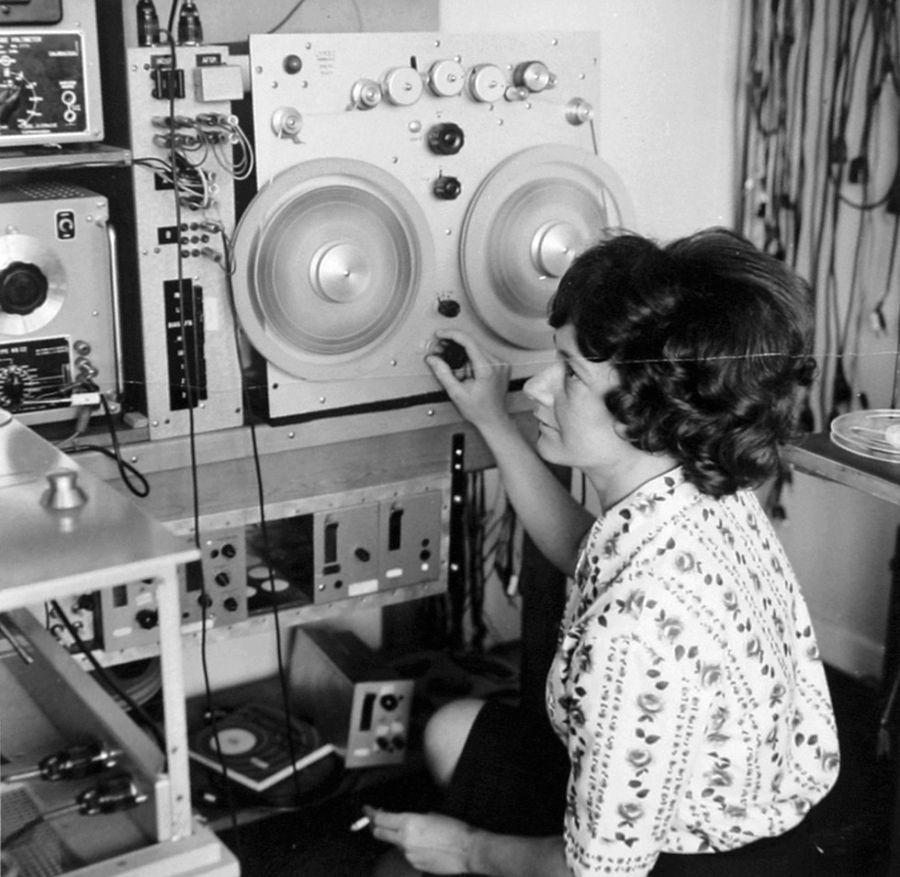By
Philip Sherburne, January 20, 2016
Else Marie Pade was the first person in Denmark to make music using electronics. A radio producer, she began composing with tape and oscillators in the 1950s, and yet she was barely acknowledged at the time, Anne Hilde Neset noted in
The Wire in 2013, comparing the composer to pioneering female electronic composers in the UK, like Delia Derbyshire and
Daphne Oram, who went largely unappreciated while alive.
It's a touching profile, not least because Neset visits the then 89-year-old composer in her nursing home, where a piano and a gigantic tape recorder both occupy a room where nurses pad around in rubber clogs. Pade's work could be forbiddingly austere, but Neset's article paints a picture of a humble, soft-spoken artist, unusually attentive to the world around her. In part, Neset suggests, that's because Pade was often bedridden as a child. It was her convalescence, in fact, that introduced her to sound's unlimited imaginative potential—laying the foundations for works like her 1955 composition
En Dag på Dyrehavsbakken (A Day at the Fair), a sound portrait of the local zoo, and 1958's
Symphonie Magnetophonique, a 19-minute composition made of everyday sounds—traffic, office noises, children playing—meant to represent a 24-hour snapshot of Copenhagen's daily rhythms.
Pade, who was both a musical pioneer and, during WWII, a prisoner of the Gestapo, died this week at the age of 91, reports Denmark's
Politiken. Her death closely follows that of
Pierre Boulez, the towering French composer who played a major role in introducing electronics to contemporary composition. Pade studied with Boulez, in fact, along with Pierre Schaeffer, whom she traveled to Paris to meet in the early '50s, and Karlheinz Stockhausen, whose courses at Darmstad she attended.
"She was a unique pioneer, one of the earliest in Denmark, and as such, for a long time very alone in the work she did," says Mats Almegård, the producer of Swedish National Radio's
Elektroniskt i P2. "There was no attention from other composers, the audience, etc.—she was too 'out there.'"
Pade was among the last living members of a founding generation of women in electronic music who are only now just beginning to get their due. The BBC Radiophonic Workshop composer Delia Derbyshire, best known for her theme for "Doctor Who," died in 2001 at the age of 64. Daphne Oram, a cofounder of the BBC Radiophonic Workshop and the inventor of a visionary electronic technique known as Oramics, died in 2003 at the age of 77. Both musicians have been the subject of considerable posthumous attention: Derbyshire's tape archive has been digitized by a group at Manchester University, and is awaiting eventual release; Oram's life and work have been the subject of anthologies, museum exhibitions, and BBC television programming.
Pade, at least, enjoyed a burst of recognition in recent years. In 2013, she collaborated with the Danish sound artist Jacob Kirkegaard, an artist 52 years her junior, on
Svaevninger, a patient study for pulsing drones and acousmatic effects that would appeal to fans of Pauline Oliveros,
Kevin Drumm, and Folke Rabe's
What?!, and in 2014, Important Records issued
Electronic Works 1958-1995, a collection of the composer's major pieces, including
Syv Cirkler, a serialist composition regarded as
Denmark's first purely electronic composition. Inspired by a visit to Brussels' world's fair in 1958, where she both hears Edgard Varèse's
Poème Electronique and encounters a multimedia planetarium,
Syv Cirkler (Seven Circles) represents the movements of the stars in an elegant array of pulses and drones; it sounds both reassuringly intuitive and deeply inscrutable, and, more than half a century after it was made, it's still hard to believe that it has not been beamed back to us from centuries in the future.
"She's a pioneer of electronic music, of course, but her work also has a depth and sensitivity which I find unmatched in many of her peers," says Important Records' John Brien.
Given
Syv Cirkler's cyclical structure, it seems fitting that the eerie composition played a key role in the preservation of her legacy. In 2001, a handful of contemporary Danish techno producers, including the Morr Music and Raster-Noton-affiliated Opiate, remixed
Syv Cirkler for the Danish Resonance.dk label; one remix, by Bjørn Svin, was even played on MTV—"a fact that Pade was very proud of," says Almegård.
The electronic music community's sudden embrace of a forgotten septuagenarian's work might have seemed improbable, but then, Pade's life was exceptional in just about every way. A member of the Danish resistance during WWII, she was imprisoned by the Gestapo when she and her friends were discovered spying on German troop movements; she was just 20 years old. Nearly driven mad by the lack of stimulus in the
Frøslev prison camp, she devised her own notational system and carved musical scores into the prison walls using the metal buckle of her garters.
Electronic music is often treated as a boys' club, but the truth is, from the very beginning, women have invented devices, techniques, and tropes that would define the shape of music for years to come; they just went unrecognized for their efforts. Reading Neset's profile of Pade, however, you don't detect any resentment on the composer's part, just an abiding fascination with the world of sound. In fact, at 89, living in an assisted living community, she was still planning new compositions based on birdsong.
Electronic Works 1958-1995 {2014 compilation - 2 CD or 3 LP}


